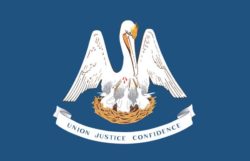Robert Kennon
Louisiana governor Robert Kennon successfully campaigned on a platform of taking a "civics book approach" to government and eliminating corruption.
A ttorney Robert “Bob” Kennon ran for the office of Louisiana governor three times, but only served one term, from 1952 until 1956. Kennon campaigned on a platform of taking “a civics book” approach to government and eliminating corruption. His administration was successful in many of its reform efforts, including the re-establishment of the state’s civil service system. Kennon is also remembered for his efforts to delay the racial integration of the state’s public schools after the U.S. Supreme Court’s 1954 decision in Brown v. the Board of Education.
Born August 21, 1902, near Minden in Webster Parish, Robert Floyd Kennon was the fifth child of Floyd Kennon and Laura Bopp Kennon. He graduated from Minden High School in 1919 and received an A.B. from Louisiana State University in 1923, where he went on to earn a law degree in 1925. After graduation he practiced law in Minden and quickly became mayor of that community. In 1931 he married Eugenia Sentell of Plain Dealing, and together they had three children.
From 1930 until 1940 Kennon served as the district attorney of Bossier-Webster parishes until he was elected to a twelve-year term as a judge in the Second Circuit Court of Appeal. The beginning of his term was delayed, however, because of the outbreak of World War II (1939-1945), during which Kennon served in the US Army and attended command and general staff school at Ft. Leavenworth in Kansas. He attained the rank of lieutenant colonel and battalion commander of artillery with the Louisiana National Guard, and served in England, France, Belgium, Holland, and Germany. By the end of the war, he was a colonel of the General Staff Corps of the U.S. Army Reserve.
Kennon returned to fill his position in the circuit court in 1945, where he remained until 1947. During part of his tenure, he also served as a justice on the Louisiana Supreme Court. In 1948 Kennon ran for unsuccessfully for governor, losing to Huey P. Long’s brother, Earl Long. Shortly after that defeat, Kennon ran for a seat in the U.S. Senate made vacant by the death of John Overton. Though defeated again, this time by Huey P. Long’s son, Russell, the race resulted in increased status and name recognition for Kennon. Four years later he won the Democratic Party nomination and eventually the race for governor, defeating Republican Harrison Bagwell by a large margin.
During his term in office, Kennon advocated the creation of independent boards to control and supervise state spending on highways, health and correctional institutions, wildlife and fisheries, and welfare. He also helped rebuild the state’s civil service system after previous administrations had gutted it. In an effort to reduce voter fraud, Kennon worked for the installation of electric voting machines in every precinct. His efforts to eliminate corruption among law enforcement officials were particularly notable, leading some to conclude that Kennon “cleaned up Louisiana’s image as the most crooked state in the nation.” Toward the end of his term, Kennon fought to forestall the implementation of the Supreme Court’s 1954 desegregation decision in Louisiana, supporting segregationists’ efforts to maintain a “separate but equal” public education system.
Ineligible to succeed himself, Kennon left office in 1954 but remained in Baton Rouge where he practiced law. He ran for governor again in 1963 but was defeated in the Democratic primary by John McKeithen, who went on to win the race. He died in Baton Rouge on January 11, 1988, and is interred in the Young Family Cemetery.
Sources: Baton Rouge Morning Advocate, obituary, January 12, 1988; Miriam G. Reeves, The Governors of Louisiana, 3rd ed. (1972); Lafayette Daily Advertiser, obituary, January 12, 1988.
Adapted from Jane B. Chaillot’s entry for the Dictionary of Louisiana Biography, a publication of the Louisiana Historical Association in cooperation with the Center for Louisiana Studies at the University of Louisiana, Lafayette. http://www.lahistory.org>
